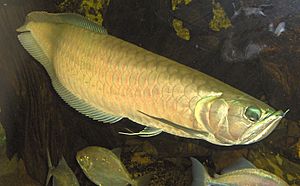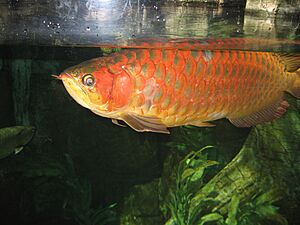Arowana facts for kids
Quick facts for kids Arowana |
|
|---|---|
 |
|
| Silver arowana, Osteoglossum bicirrhosum | |
| Scientific classification |
|
| Kingdom: | Animalia |
| Phylum: | Chordata |
| Class: | Actinopterygii |
| Order: | Osteoglossiformes |
| Suborder: | Osteoglossoidei |
| Family: | Osteoglossidae Bonaparte, 1831 |
| Genera | |
|
|
Arowanas are cool freshwater fish. They belong to a family called Osteoglossidae. People sometimes call them "bony tongues" because they have a special bone in their mouth that looks like a tongue with teeth!
These fish have a bony head and a long body covered in big, strong scales. Their fins are soft and long, but their front fins (pectoral and ventral) are small. Arowanas can even breathe air! They suck air into a special organ called a swim bladder, which works a bit like a lung.

Contents
Ancient Fish: Arowana's History
Arowanas are very old fish! They first appeared a long, long time ago, during the time of the dinosaurs. They are part of a group called Osteoglossiformes.
Today, you can find different types of arowanas in South America, Asia, and Australia. There used to be an African arowana, but scientists now put it in a different fish family.
The South American arowanas (called Osteoglossum) and the Asian and Australian arowanas (called Scleropages) separated from each other about 170 million years ago. That's a super long time!
It's interesting that arowanas are found in freshwater on both sides of the Wallace Line, which is a famous boundary for animals in Asia and Australia. Scientists think that Asian arowanas might have traveled to Asia on the Indian subcontinent when it moved across the Earth.
Fossils: Clues from the Past
Scientists have found many fossils of arowanas. These fossils show us that arowanas have been around for millions of years. Some of the oldest arowana fossils are from the Late Cretaceous period. Even older fossils, from the Late Jurassic or Early Cretaceous, are thought to be from the same supergroup as arowanas.
Arowana fossils have been found on every continent except Antarctica! This shows how widespread these ancient fish once were.
Arowana Behavior: What They Do
Arowanas are meat-eaters. They often hunt for food right at the water's surface. They are amazing jumpers! Some arowanas in South America have been seen leaping over 6 feet (almost 2 meters) out of the water. They do this to snatch insects and even small birds from branches hanging over the water. That's why some people call them "water monkeys"!
Most arowana species grow to be about 2 to 3 feet long when kept in tanks.
Arowanas can be tricky pets to keep. They are expensive, need a lot of space, and can be picky eaters. They also need a lot of care. Arowanas are known for being quite aggressive and having strong personalities.
Arowana Reproduction and Family Life
Many arowana species take good care of their babies. They build nests and protect their young after they hatch from eggs. All arowanas are mouthbrooders. This means the parents hold hundreds of eggs inside their mouths to keep them safe!
The baby fish will sometimes swim out of the parent's mouth to explore, then quickly swim back in if they feel scared. They do this a few times before finally leaving for good.
Unlike most fish that can have babies when they are about six months old, arowanas usually need to be three to four years old before they can reproduce.
Arowanas as Pets
There are about 10 types of arowanas that people often keep as pets. These come from Asia, South America, and Australia.
The Asian arowana is a very special fish. It is an endangered species, which means it's at risk of disappearing. Because of this, it's illegal to own them in the United States. In some parts of Asia, Asian arowanas are seen as a symbol of wealth. One albino arowana was even sold for a record price of $300,000 in 2009! Most pet arowanas are raised on special farms with high security.
Arowanas are usually solitary fish, meaning they like to be alone. When they are young, they might get along with other fish, but adult arowanas can be very dominant and aggressive. If you keep them with other fish, you need to choose species that are also somewhat aggressive and too big for the arowana to eat. Some fish that can sometimes live with arowanas include clown knifefish, pacu, oscars, and gar.
Arowanas grow very quickly! They can outgrow a tank in just 8 to 10 months. A very large aquarium, at least 6 feet long, 3.5 feet wide, and holding 300 gallons of water, is the minimum size suggested. But a tank of 400-800 gallons is even better for them. Australian arowana species are usually best kept by themselves in a tank.
The business of selling Asian arowanas as pets is very big. It's estimated to bring in over $200 million globally each year since 2012.
Etymology: What's in a Name?
The name "arowana" comes from the Tupí language, which is spoken by some native people in South America. The words arua'ná, aruanã, or arauaná are where the name comes from.
Images for kids


